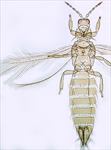
Female
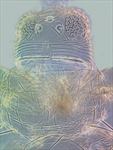
Head & pronotum

Antenna
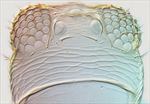
Head
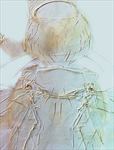
Pro, meso & metanota
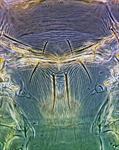
Meso & metanota
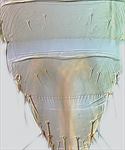
Tergites VII–IX

Sternites VI–VII

Fore wing
Both sexes fully winged. Body and legs yellow, major setae light brown; antennal segments IV–V brown distally, VI–VII brown; fore wings pale. Antennae 7-segmented; segments III & IV with short forked sense cone; VII short. Head wider than long; two pairs of ocellar setae; pair III small, arising within the ocellar triangle behind the first ocellus; postocular setae pair I slightly longer than ocellar setae III. Pronotum with 2 pairs of long posteroangular setae; posterior margin with 3 pairs of setae. Metanotum with irregular longitudinal lines converging to posterior margin, at anterior with curving transverse lines; median setae arising behind anterior margin; campaniform sensilla present. Fore wing first vein with 3 (sometimes 2) setae on distal half; second vein with row of about 15 setae. Abdominal tergite II with 4 lateral marginal setae; tergites V–VIII with paired ctenidia laterally, on VIII posteromesad to spiracles; tergite VIII posteromarginal comb complete, microtrichia long and slender; pleurotergites without discal setae. Sternite II with 2 pairs of marginal setae, III–VII with 3 pairs; sternites without discal setae.
Male smaller than female; tergite VIII with marginal comb complete medially; sternites III–VII with narrow transverse pore plate.
This species is remarkably similar in structure to the tropical pest, T. palmi, but has ocellar setae III arising inside the ocellar triangle behind the first ocellus. The genus Thrips is the second largest genus in the Thysanoptera, and currently includes, worldwide, about 295 species. All members of this genus lack ocellar setae I on the head, and they all have ctenidia on tergite VIII posteromesad to the spiracles. Other characters, such as number of antennal segments, number of setae on the fore wing veins, and number of discal setae on the sternites are variable between species (Palmer, 1992; Nakahara, 1994; Mound & Masumoto, 2005).
Apparently highly polyphagous, and breeding in flowers and on leaves, but not usually regarded as a serious pest species.
Widespread across Eurasia from Britain to China, Japan and Taiwan, but not recorded from any part of North America (Nakahara, 1994); included here for quarantine detection convenience in California.
THRIPIDAE - THRIPINAE
Thrips flavus Schrank
Thrips flavus Schrank, 1776: 31
Thrips melanopa Schrank, 1776: 31
Thrips ochraceus Curtis, 1841:228
Physothrips flavidus Bagnall, 1916: 399
Thrips flavidus Bagnall, 1916: 402
Thrips flavosetosus Priesner, 1919: 105
Thrips obscuricornis Priesner, 1927: 423
Physothrips flavus Bagnall, 1928: 98
Taeniothrips clarus Moulton, 1928: 287
Thrips kyotoi Moulton, 1928: 302
Thrips nilgiriensis Ramakrishna, 1928: 262
Taeniothrips luteus Oettingen, 1935: 183
Taeniothrips sufuratus Priesner, 1935: 358
Thrips biarticulata Priesner, 1935: 358
Taeniothrips saussureae Ishida, 1936: 70
Taeniothrips rhopalantennalis Shumsher, 1946: 181.
Mound LA & Masumoto M (2005) The genus Thrips (Thysanoptera, Thripidae) in Australia, New Caledonia and New Zealand. Zootaxa 1020: 1–64.
Nakahara S (1994) The genus Thrips Linnaeus (Thysanoptera: Thripidae) of the New World. United States Department of Agriculture. Technical Bulletin 1822: 1–183.
Palmer JM (1992) Thrips (Thysanoptera) from Pakistan to the Pacific: a review. Bulletin of the British Museum (Natural History) Entomology Series 61 (1): 1–76.
zur Strassen R (2003) Die terebranten Thysanopteren Europas und des Mittelmeer-Gebietes. Die Tierwelt Deutschlands 74: 1–271.